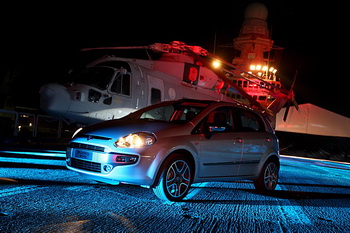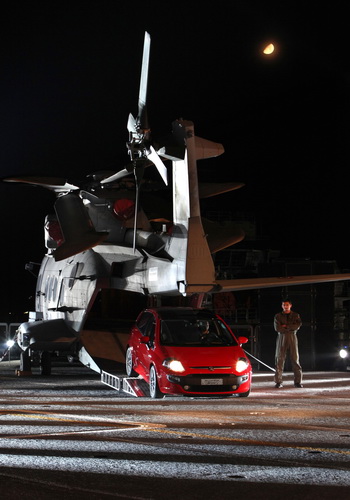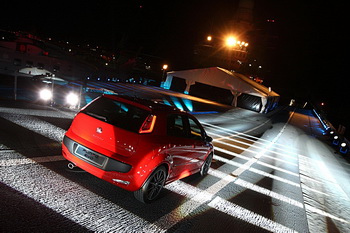

 |
|
The new Fiat Punto Evo has been presented to
the international media on board the Cavour
aircraft carrier, the new flagship of the
Italian Navy which is the country's largest
post-war naval construction and the biggest
technological investment by the defence
ministry. |
|
 |
|
|
|
The new Fiat
Punto Evo has been presented to the international media on
board the Cavour aircraft carrier, the new flagship of the
Italian Navy which is the country's largest post-war naval
construction and the biggest technological investment by the
defence ministry. The project to build the ship, known as
NUM, began in November 2000. It involved the Navy teaming up
with national shipyard Fincantieri and the national defence
industry to adopt the latest design and construction methods
and develop advanced systems. The fruit of their joint
labour is now a symbol of global prestige for the entire
Italian military and industrial system.
Both the Cavour aircraft carrier and the Punto Evo are
symbols of technological excellence and of Italy,
representing the culmination of an evolutionary process
involving advanced technologies and innovative features.
That is why the Cavour flagship was the perfect launch-pad
for a car that wants to be at the forefront of engine
innovation, respect for the environment, safety and style.
Cavour and the
Navy
A single Italian naval organisation was created on 17
November 1860 by the unification of the Sardinian, Bourbon,
Sicilian, Tuscan and Papal navies, changing its name to the
Regia Marina (Royal Navy) when the Kingdom of Italy was
established on 17 March 1861. "I want ships that can serve
the entire Mediterranean, carrying the most powerful
artillery, travelling at top speeds and containing large
quantities of fuel," said Camillo Benso, Count of Cavour,
Prime Minister and Minister of the Navy, the day after the
creation of the new Navy Ministry. Cavour's naval career had
begun 11 years earlier when, in the Kingdom of Sardinia, he
had become head of the departments of Agriculture, Trade and
the Navy, the latter having been separated from the War
Ministry in October 1850. Cavour showed great determination
as soon as he became involved in naval affairs: "I will put
all my efforts and whatever parliamentary influence I can
achieve into ensuring that the organisation of our Navy
meets the needs of the country."
The newly created Kingdom of Italy boasted a Navy with a
large number of boats thanks to the sum of the
pre-unification fleets. However, it would take more than
that to build a truly unified Navy in both an operational
and spiritual sense. No-one knew this better than Cavour.
The statesman immediately set about an extensive programme.
First of all, he dissolved the naval ministries of Naples
and Sicily and reorganised all civilian and military staff.
Then he divided up the long Italian coastline into three
departments (Genoa, Naples, Ancona) and funded a modern
arsenal construction programme at La Spezia, which he turned
into a first-class naval base.
The first directives issued by the Count underlined the
Mediterranean leanings of his policies. This was also
against a background of increasing importance for the basin
which, with the opening of the Suez Canal (on 17 November
1869), was becoming a short cut to the Indias and the centre
of naval interest on a global scale. What was achieved in
terms of naval construction on the back of the
post-unification directives issued by the statesman was
known as the Cavour Programme. A programme that would
outlive its creator, who died on 6 June 1861 at just 51
years of age.
Cavour realised that technological developments demanded
modern construction criteria for the new ships, but also
that these innovations were not ready because such
developments had only just got underway at Italian
shipyards. The smaller ships of the "Armata Navale" - as the
fleet was known in those days - were set up in the national
shipyards: the second-class battleships Principe di
Carignano, Messina, Roma, Venezia, Conte Verde, all with
wooden hulls. The two first-class battleships, the Re
d'Italia and the Re di Portogallo, were commissioned in the
United States. The battleships Ancona, Castelfidardo, Maria
Pia and San Martino, the corvettes Formidabile and Terribile
and the gunboats Palestro and Varese were built at the
French shipyards. The Affondatore battleship, one of the
first tower ships in naval history, was ordered in England.
That is how Cavour played a fundamental role in the birth of
the Italian Navy.
The Cavour Ship: name and
history
War ships are good symbols of the most noble values of a
nation, capable of representing and displaying them at any
time. Their names are important means of communication,
summarising their content and spreading it beyond military
circles. After the name assigned to the Garibaldi ship, with
the aim of promoting the homeland, it was decided to name
the new aircraft carrier after another major founder of the
unified Italy, Camillo Benso Count of Cavour, whose
commitment and work are a perfect complement to the
undertakings of Garibaldi. This is how the Navy's largest
ships came to bear the names of Italy's founding fathers
with pride. The Cavour aircraft carrier is the latest Navy
ship to bear the name of the illustrious statesman.
The Conte di Cavour battleship, launched in 1911 and
reconstructed between 1933 and 1937, featured in the Second
World War and, after coming under attack at the Battle of
Taranto in November 1940, it was restored in Trieste in
1941; it remained in service until 1947. Construction of the
current aircraft carrier began in the Riva Trigoso shipyard
on 17 July 2001; because of its size, the ship was built in
two separate parts that were then joined together. The bow
was built at the Muggiano shipyards and the stern at Riva
Trigoso. The main ship was launched on 20 July 2004 at the
Genoa naval shipyard in the presence of President Carlo
Azeglio Ciampi. The platform was then assembled at Muggiano.
The aircraft carrier was delivered to the Italian Navy on 27
March 2008.
Main specifications (2004)
Shipyards:
FINCANTIERI - Muggiano and Riva Trigoso
Start of construction:
17 July 2001
Displacement: 27,500
t
Overall dimensions:
244 x 40 m
Flight deck dimensions:
220 x 34 m
Immersion: 7.70 m
Propulsion: Combined
Gas And Gas (COGAG), two axles, variable pitch propellers,
four gas turbines AVIO-GE LM-2500
Power: 88 MW (120,000
hp)
Top speed: more than
30 knots
Range: 7,000 miles at
16 knots
Weapons: 3 Oto/Breda
25/80 machine guns; SAAM/IT missile system (4 eight-cell
modules for ASTER 15 missiles); 2 SCLAR H anti-missile
rocket launchers; 2 SLAT anti-torpedo systems; A maximum of
24 aircraft comprising: 1.AV8-B II Plus and F-35B Lightning
II planes; 2.EH-101, NH-90, SH-3D and AB-212 helicopters
Transport carrying capacity:
wheeled, caterpillar and armoured vehicles, including Ariete
tanks
Main radars: RASS,
RAN-40L, EMPAR
Crew: 530 (including
39 Officers)
On-board capacity:
1210
The Cavour, the new flagship of the Italian Navy, is a
modern and flexible vessel, able to carry out a wide range
of missions to service national foreign policy such as
supporting peace operations, preventing international crises
and defending naval communication routes. The Cavour ship is
proof of Italy's industrial and technological skills.
A modern ship at the service
of Italy
The Cavour aircraft carrier is the biggest post-war naval
construction and the largest technological investment by the
Defence Ministry. The project to build the ship, known as
NUM, began in November 2000. It involved the Navy teaming up
with national shipyard Fincantieri and the national defence
industry to adopt the latest design and construction methods
and develop advanced systems. The fruit of their joint
labour is now a symbol of global prestige for the entire
Italian military and industrial system. The Cavour is one of
the major ships able to manage international missions, in
far-flung places, for global security, stability and
protecting national interests in different regions.
The operational experience of the Navy in recent years -
with missions in Lebanon, the Persian Gulf, Somalia, the
Indian Ocean, the Arabian Sea, East Timor, Kosovo and the
former Yugoslavia - has confirmed the efficiency of the
biggest ships. These are notable for their command, control,
communication and transport capacities that allow them to
serve as airports, hospitals, command centres and logistical
structures to effectively support, from the sea, ground
troops in conflict areas. In the summer of 2006, during
Operation Leonte in the Lebanon, the presence of the
Garibaldi and the three other amphibious helicopter carriers
was crucial for managing, unloading, protecting and
supporting the landing troops and special ground forces,
while at the same time ensuring a broad range of maritime
surveillance in the waters of the conflict zone.
The Cavour is destined for the role of Italian fleet
flagship because of its dedicated command, control,
communications and operational planning areas, which are
five times larger than those on the Garibaldi. Although
larger and more powerful, the Cavour will be run by a
smaller crew than the Garibaldi (530 crew members compared
with 600 - around 12 per cent fewer) thanks to the increased
automation that characterises the Navy's most modern ships.
Using the Cavour as the Italian aircraft carrier will free
up the Garibaldi for amphibious protection duties, using its
capabilities in the national sea protection body "Capacitą
Nazionale di Proiezione dal Mare (CNPM)" until a new
amphibious ship comes into service.
Bigger ships are required in strategic situations of varying
instability and conflict intensity, on a regional and global
scale, that increasingly require military forces to
effectively support diplomatic missions and steps to manage
international crises, and to restore security and stability.
In this context, there is an increasing demand for mobile,
flexible and self-sufficient forces that are readily
available and can be moved to different locations to deal
with a wide range of situations, from protecting national
interests where threatened to resolving crises and keeping
the peace, including humanitarian missions and rescues in
the event of a natural disaster.
For these operations, the national vessel is increasingly
called upon to make important contributions to national and
international security as part of interforce and
multinational coalitions. Carrying out such operations
involves various types of mission that fall under the
following main categories:
- maritime surveillance, including air and sea deep sea and
coastal activities, defending air space at sea, contributing
to air defence of a territory, protecting maritime routes of
communication, policing the high seas and gathering
information. For such activities, the Cavour can be used as
a command ship able to make an invaluable contribution with
its own weapon systems and sensors, including on-board
aircraft;
- protection, at sea and from the sea, across the range of
naval operations, including amphibious and interforce
operations, for assisting and evacuating compatriots from
danger zones and providing air, medical and logistical
support to military units and civilian organisations on the
ground.
Thanks to its versatility, the Cavour is an advanced vessel
that combines the features and capabilities of several
different types of ship: aircraft carrier, command platform,
surveillance unit and air and sea defence. Its flexibility
and mobility, together with its notable logistics
capabilities and standout command, control and communication
skills, mean the Cavour has a central role in protection
missions, both at sea and from the sea, in different
interforce and multinational situations. In short, it is a
modern ship at the service of Italy. The Cavour's motto is:
In arduis
servare mentem.
ItaliaspeedTV -
Fiat Punto
Evo media presentation on Cavour aircraft carrier
|